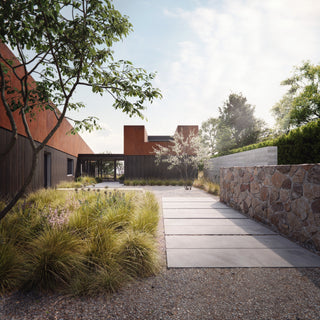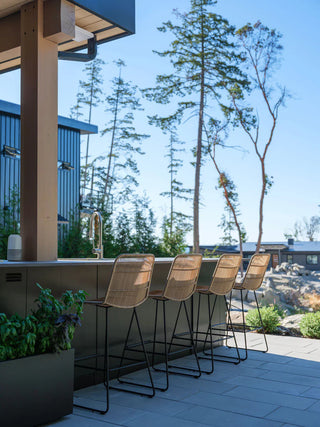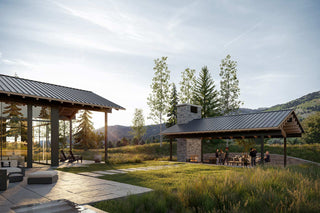
Interview
Wellness al Fresco: Talking Outdoor Kitchens with Vera Iconica
By Renee Soucy
We sat down with Blair Costello, Principal, Director of Interiors and Healthy Living, and Shane Salisbury, Principal Architect, Director of Design AIA, NCARB of Vera Iconica Architecture to gain their insights on the past, present, and future of designing for wellness outdoors.
Ask twenty people to define what wellness means to them and chances are you’ll get twenty distinctly different answers touching upon the pursuit and maintenance of complete physical, mental, and emotional well-being. For some, the idea of wellness relies upon a dedicated fitness regime or dietary restrictions. For others, it means making the time and space to build meaningful experiences and memories with those they love. Despite the myriads of personal interpretations, a well-designed built environment can significantly enhance overall well-being by fostering physical activity, reducing stress, and promoting a sense of connection to others and to nature.
In their essence, outdoor kitchens not only encourage these outcomes but actually enable them by design, connecting us with the natural elements, promoting healthier nutritional choices, and bringing friends and family together. As the field of wellness continues to develop and become mainstream, experts and everyday folk concur: food prepared and shared outdoors benefits the mind, body and the soul.
Vera Iconica Architecture, a Jackson, Wyoming-based firm renowned for its expertise in Wellness Architecture, understands the profound impact of the built environment on human health and well-being. Their evidence-based approach subtly influences daily habits, rituals, and overall mood while their innovative thinking consistently attracts clients from around the globe, including wellness pioneer Deepak Chopra. We first met members of their team at an event held in a private residence in Park City, Utah where we had gathered near the outdoor kitchen, savoring the view and the flavors coming off the grill. Within a matter of minutes, a shared passion for intentional living and an appreciation for life's simple pleasures planted the seed for this profile. A few weeks later we connected with Blair Costello (Principal, Director of Interiors and Healthy Living) and Shane Salisbury (Principal Architect, Director of Design AIA, NCARB) to gain their insights on the past, present, and future of designing for wellness outdoors.
Naturally, we were particularly interested to hear their thoughts on how designing for the preparation and enjoyment of fresh food outdoors aligns with the pursuit of wellness in all its many forms.
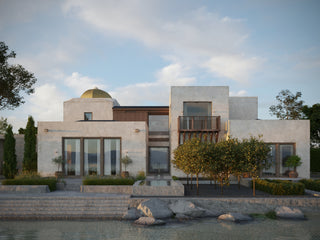
Transforming Routine into Ritual
At the start of our conversation, Blair emphasized the foundational principles of wellness design, highlighting an approach that prioritizes not only the physical attributes of a space—proportions, materials—but also the well-being of its occupant. “It comes down to designing an experience where you can foster meaningful outcomes. This process begins by first understanding who will be using the space and what kind of lives they lead. Shane and I primarily do custom residential work and on those projects we would rarely, if ever, silo out dining, entertaining, and wellness as separate from everything else because in our work, it's as much about a lifestyle as it is a built environment. Subtly encouraging nourishment - whether through wholesome, well prepared meals, or through the psychological benefits that are derived from gathering - that's a true wellness experience.”
Shane continues: “We talk a lot about elevating routine into a ritual. The pleasure found in the small moments that make up our daily life, like chopping vegetables or making a pot of tea, can be amplified by the way that spaces are set up. We go in-depth with clients to understand and identify where those opportunities exist and then, with this knowledge, each design is customized to their lives.”
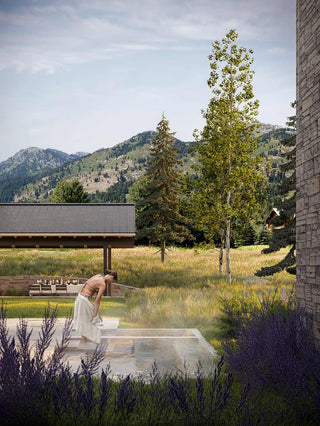
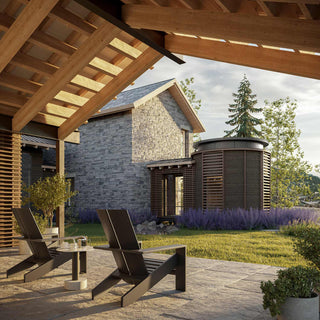
The Science of the Nudge
While early explorations into wellness often leaned towards new age concepts, contemporary wellness architecture is grounded in robust scientific research; drawing upon evidence from psychology, neuroscience, environmental science, and human factors engineering to create built environments that demonstrably enhance human health and well-being.
“Yes, there is a lot of science behind this,” Blair explains. “One of the theories we like to employ regularly is the idea of Nudge Theory. We ask: “How can we help make the healthy choice the easy choice?” By incorporating features like outdoor kitchens and herb or vegetable gardens, our clients are intuitively making healthier choices all the time.”
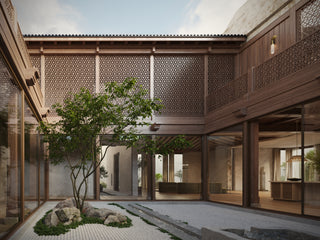
Material Matters
The choice of materials used in a space can significantly impact its overall health and well-being, affecting factors like air quality and even emotional response – facts that Blair, a graduate of Parson’s Healthy Materials and Sustainable Buildings program, knows intimately. “When it comes to materiality for us, the biggest drivers are: are the materials non-toxic? You don't want them off-gassing into the food products that you're storing within them and then, beyond that, will they stand the tests of time in a sometimes-harsh environment, particularly (the climates of) Utah, Wyoming, Colorado, Montana and the Mountain West? High-quality, long-lasting, durable, and site-specific are real drivers when it comes to materiality.”
Modular outdoor kitchen systems also align with sustainability principles by prioritizing longevity and adaptability. Unlike fixed outdoor kitchens, a modular approach allows for easy customization and upgrades to happen as and when lifestyle needs evolve, reducing the waste associated with complete replacements and encouraging a more circular, sustainable, approach to consumption.
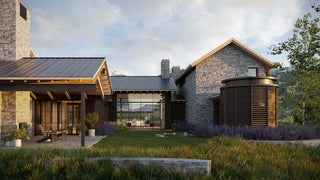
Innovation Through Deceleration
As the pace of life, fueled by breakthroughs in technology like AI, continues to accelerate, Vera Iconica are envisioning a future which enables a more considered, durable, and slower lifestyle. “Our firm has been talking about Maslow's Pyramid, the hierarchy of needs, for a long time,” Blair observes. “Our clients already have their fundamental physiological needs like shelter and safety met. We are tasked with helping guide them towards their highest potential – into self-actualization - and discovering how the built environment can help facilitate that.”
Ultimately, the pursuit of wellness is a deeply personal journey. However, by thoughtfully integrating design principles that prioritize human connection, mindful movement, and a harmonious relationship with the natural world, our living spaces can provide much more than just shelter. As Vera Iconica demonstrates, outdoor kitchens can also serve as a powerful microcosm of this approach, transforming everyday routines into rituals and cultivating a more intentional, fulfilling lifestyle.
Images Courtesy of Vera Iconica


